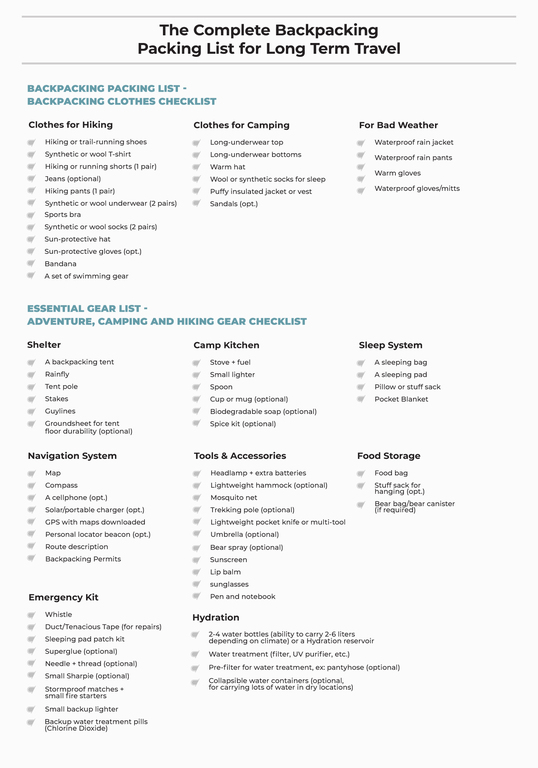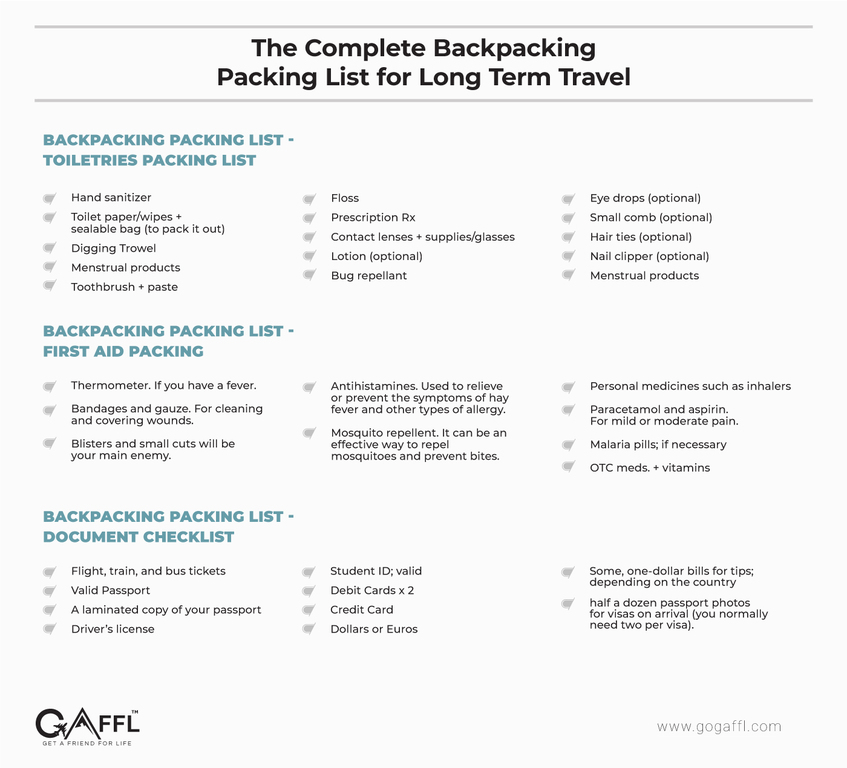Keep Your Pack light. Long term travel is all about packing light but making sure you have all the essentials to make travel as easy as possible. Whether you’re camping or hiking, traveling to Asia or Europe on a budget, you just need to travel as light as possible.
It’s much easier to do laundry than to carry weeks worth of clothing. So, you don’t need to carry too many clothes.
Focus on items that will be useful to you all the time or have multiple uses. Keep in mind you can often rent gear locally, or find a cheap temporary fix instead of carrying something for one-time use.
If you forget something, there are shops all over the world and you can buy it there.
4- Don’t pack at the last moment
Pack the day before your trip starts. If you’re in a hurry, you might stress out and stuff your bag too full.
5- Try to keep a quarter of your bag empty
Loading unloading would be so easier and you can use that free space for storing gifts and souvenirs.
Backpacking Necessities - Essential Backpacking Items
Your passport, wallet, and your phone. These are the most important things you have while you’re traveling. Here are some other essential items for any backpacking trip.
1. A Backpack
You can’t be a backpacker without a backpack! This is the first important item on this backpacking packing list.
It’s better to go for a lightweight and versatile pack (and possibly carry-on size). It’ll be more comfortable to carry. There are other few features worth keeping an eye on:
Front loading. Many backpacks are top-loading, with a drawstring to close it at the top. It means having to dig around awkwardly to get something from the bottom. Instead, bags with a clamshell design are much nicer: you just zip them open face down, with everything within instant reach.
Waist Strap. Do you want to avoid sore shoulders and bad backs? Using a waist strap distributes the load around your whole body instead of just your shoulders and it’s essential for avoiding sore shoulders and bad backs.
Laptop compartment. A separate padded compartment keeps your laptop secure. You can also use these zipped compartments for books, travel journals, or many other things.
Rain resistant. You don’t want the water to leak into your bag, right? So, you should always look at whether it’s weather-sealed or includes a rain cover.
Lockable zippers. O-rings that let you attach a padlock or wire lock to prevent opportunistic theft.
Internal or external compression straps. This will help you pack more and organize better.
Good carry handles. It’s important when you’re not wearing the pack on your back.
The Best Travel Backpacks
Osprey Farpoint 40
Osprey Porter 46
A popular bag that’s sturdier and better organized than the Osprey Farpoint.
But, exceeds carry on size limit, and the straps are not as comfortable.
Osprey Farpoint 55 trek
Like a premium version of the original Farpoint
More space, adjustable suspension system, comfortable trampoline-style back & integrated rain cover
Ideal for long term travel.
Tortuga Setout
Peak Design 45L Backpack
AER Capsule Pack
Great for city travel & one-bag travelers
Minimalist design with a large main compartment
A really solid carry-on that I like a lot
Backpack sizes are typically expressed in liters (i.e., the volume they can contain). Here are some of the common sizes:
15-30L. Too small unless you’re going on a weekend trip, or you’re super minimalist. This size is usually for day-packs or commuter bags.
35-45L. Perfect for shorter trips but equally for trips lasting many weeks or months (if you know how to pack light). Ideal for traveling within one climate and don’t need to pack for every type of weather. This size is usually accepted as carry-on luggage, saving you time and check-in fees when flying.
50-65L. Good if you need extra space. Not everyone is a light packer so some will prefer these sizes despite the extra weight.
70-120L. Only for trekking and camping expeditions. The internal support frames often already weigh several kilos. This is overkill for most travelers. But if you need to store a tent and other gear, this might be the size for you.
Carry-ons (around 40 liters) are often the best backpacks for traveling — if you’re staying in hostels and don’t need to bring any bulky gear. You’ll end up with less weight on your back and more freedom of movement.
2. A Good Day Pack
Usually, you’ll have your day pack with you while your backpack is in the hostel.
Daypacks are essential for urban and remote adventures. You can easily pack everything you need including your water bottle, snacks, layers, and anything you might purchase while exploring a new city!
3. A Micro-fiber Towel
A proper travel towel is an essential thing to have for your trip. You don’t get towels in most backpacker hostels and you can’t take your hotel’s bath towel with you.
Regular towels are heavy and take up a ton of space. You can use micro-fiber dry towels. Micro-fiber towels take almost no space, are lightweight, and dry easily so that they won’t get moldy and start smelling.
4. Travel Security Money Belt
Nobody will know you have money on you! It has a hidden inner pocket in which you can hide your cash.
Traveling with a money belt is a small investment that helps keep your money safe.
Check out The 9 Best Travel Money Belts of 2020.
5. Combination Padlocks
Carry small combination padlocks to lock backpacks or hostel lockers.
Padlocks are important for a few reasons.
First, padlocks are essential when you stay in hostels. Most hostels provide some sort of lockers, but not all of them provide locks for those lockers.
Second, connect the lock between two zippers and make your bag safe from thieves.
If you frequently lose your room keys when staying in hostels, you can use a padlock to lock your room.
6. International Travel Power Adapter
Carry a universal travel adapter with two USB ports. This means you never have to worry about all the different electrical sockets used around the world. You can charge your laptop and two other electrical devices via USB at the same time.
7. Swiss Army Knife
One of the most valuable travel tools is a swiss knife. This will be needed to open cans and cut stuff.
Remember to put it in your check-in luggage before flights.
8. A Backpacking Toiletry Bag
To keep all your toiletries and meds in one place, you need a backpacking toiletry bag. It will be extremely helpful when you use a shared bathroom.
9. A Laundry Bag
Having a laundry bag helps out so much if you want to separate your dirty clothes from the rest.
10. An LED Headlamp
A headlamp comes in handy when you have to find your way through a dorm room at night when there’s a power cut (not unusual in developing countries), or when you’re hiking at night or going on a caving adventure. A regular torch works too, but having a light strapped on your head keeps your hands free.
Backpacking Packing List - Electronics Checklist
1. A Laptop
If you work on the road or take online classes, good quality, light, and a fast laptop is an essential item for you. But if you don’t, then an iPad or a tablet would be fine for watching movies, staying in contact with others, and reading books.
2. Camera
If you love photography, you can bring a bigger camera with an interchangeable lens system. The most lightweight option is obviously to use a compact camera or a smartphone.
But if you prefer a fully-featured camera, you can use a DSLR camera.
Check out this detailed post for a breakdown of the best travel cameras, if you’re really interested in travel photography.
3. A Smartphone
If you have a smartphone with a good quality camera, you might not need a DSLR camera on your trip. It totally depends on how much you care about your photos.
4. Power Bank
It is extremely important to keep your phone, Go-pro, or other electronic devices charged whilst exploring.
5. Earphones
Carrying earphones with you is a must.
Backpacking Packing List - Backpacking Clothes Checklist
The clothing you pack will change slightly depending on the conditions you expect to encounter on specific trips, but the fundamentals remain the same.
Nylon, polyester, wool, bamboo, silk, and synthetic blends are all good options. Avoid cotton, it absorbs moisture and takes a long time to dry, which can cause a variety of problems including blisters and chafing.
Choose items that can be worn together in layers. The key to packing light and keeping warm in colder temperatures is layering instead of using bulky winter clothes.
Rain gear should be lightweight, breathable, and waterproof.
Clothes for Hiking
Hiking or trail-running shoes
Synthetic or wool T-shirt
Hiking or running shorts (1 pair)
Jeans (optional)
Hiking pants (1 pair)
Synthetic or wool underwear (2 pairs)
Sports bra
Synthetic or wool socks (2 pairs)
Sun-protective hat
Sun-protective gloves (opt.)
Bandana
A set of swimming gear
Clothes for Camping
For Bad Weather
Waterproof rain jacket
Waterproof rain pants
Warm gloves
Waterproof gloves/mitts
Essential Gear List - Adventure, Camping and Hiking Gear Checklist
If you camp, hike or dive a lot, you know you’ll need to carry more gear. This gear checklist has got you covered on everything you’ll need for your epic hiking or backpacking trip.
Shelter
Sleep System
A sleeping bag
A sleeping pad
Pillow or stuff sack
Pocket Blanket
Camp Kitchen
Tools & Accessories
Headlamp + extra batteries
Lightweight hammock (optional)
Mosquito net
Trekking pole (optional)
Lightweight pocket knife or multi-tool
Umbrella (optional)
Bear spray (optional - only for the grizzly country)
Sunscreen
Lip balm
sunglasses
Pen and notebook
Navigation System
Emergency Kit
Food Storage
Hydration
2-4 water bottles (ability to carry 2-6 liters depending on the climate) or a Hydration reservoir
Water treatment (filter, UV purifier, etc.)
Pre-filter for water treatment, ex: pantyhose (optional)
Collapsible water containers (optional, for carrying lots of water in dry locations)

Backpacking Packing List - Toiletries Packing List
Bring only as much as you anticipate needing.
Backpacking Packing List - First Aid Packing
Pack a first aid kit designed for where you are going.
Thermometer. If you have a fever.
Bandages and gauze. For cleaning and covering wounds. Blisters and small cuts will be your main enemy.
Antihistamines. Used to relieve or prevent the symptoms of hay fever and other types of allergy.
Mosquito repellent. It can be an effective way to repel mosquitoes and prevent bites.
Personal medicines such as inhalers
Paracetamol and aspirin. For mild or moderate pain.
Malaria pills; if necessary
OTC meds. + vitamins
Backpacking Packing List - Document Checklist
Flight, train, and bus tickets
Valid Passport
A laminated copy of your passport
Driver’s license
Student ID; valid
Debit Cards x 2
Credit Card
Dollars or Euros
Some, one-dollar bills for tips; depending on the country
half a dozen passport photos for visas on arrival (you normally need two per visa).

Packing light will give you a lot of benefits, but not everyone will want to travel in the same way. If you feel a larger bag and more options are better, you should go for it. If you’re going on a flashy holiday and you want to wear something fancy every evening or at the party, it’ll be more difficult to be truly minimalist.
I hope this post has been helpful. Just make sure you give it a good test run before your trip and avoid packing at the last minute.
Happy travels.

